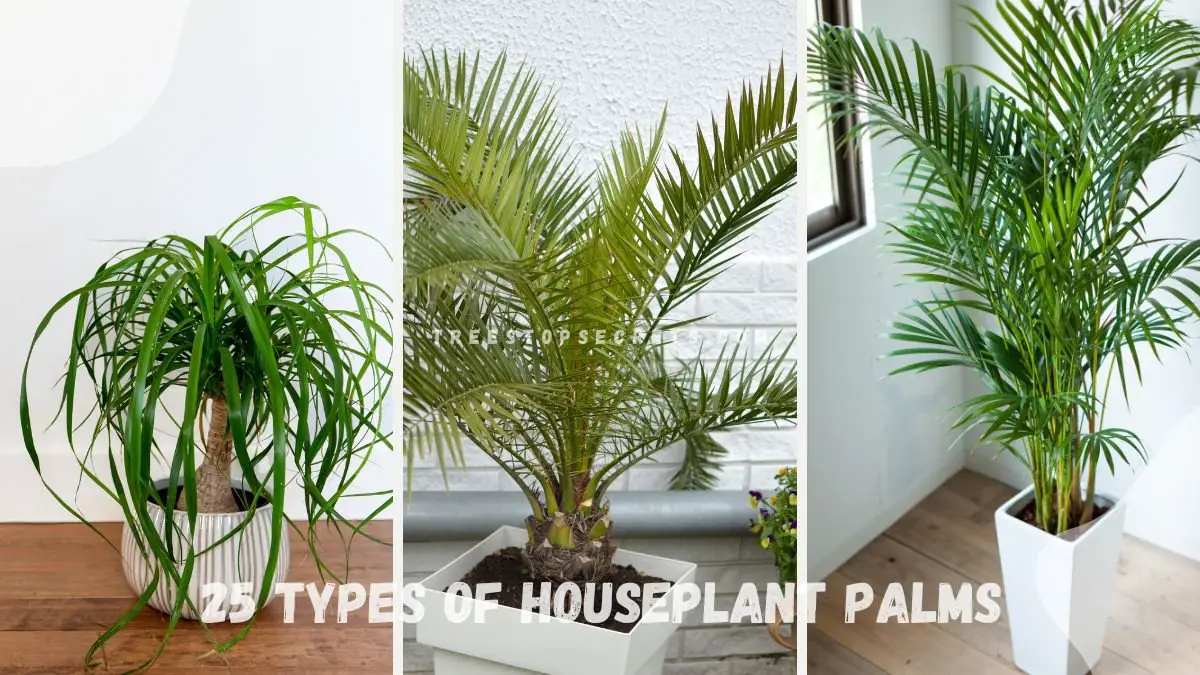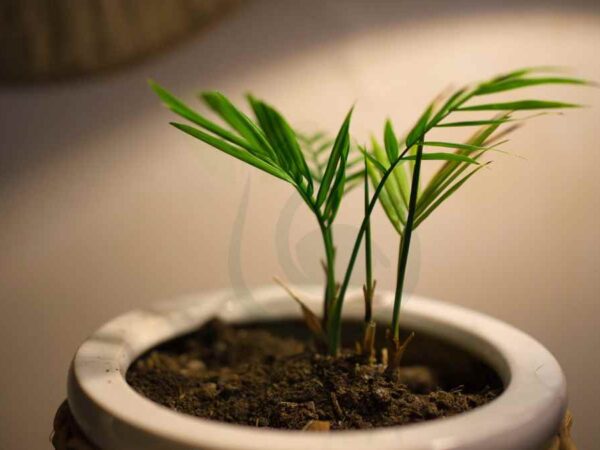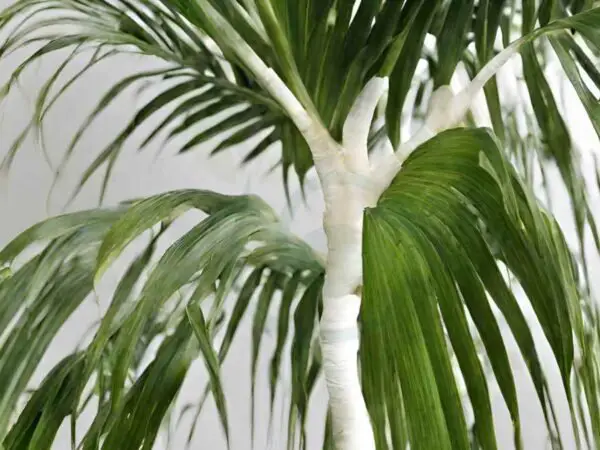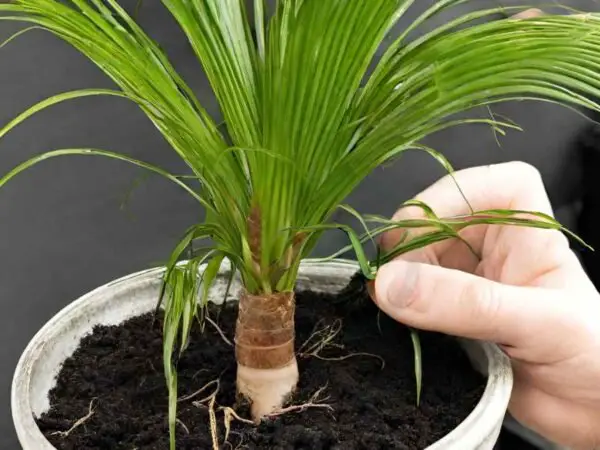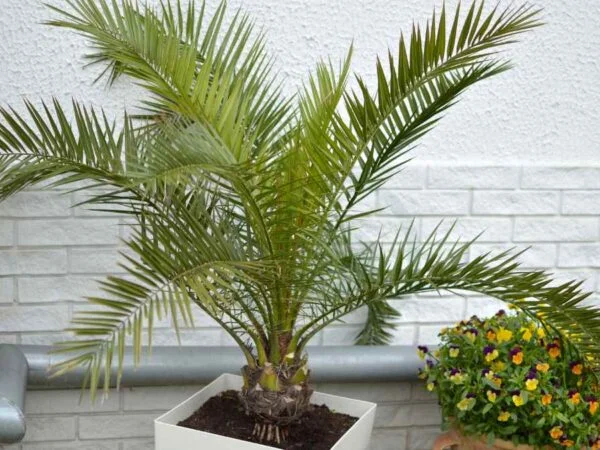If you’re looking to bring a tropical feel to your home, understanding the types of houseplant palms can be a great starting point. Houseplant palms are popular for their lush, green fronds and their ability to thrive indoors with proper care. Whether you're a beginner or a seasoned plant enthusiast, knowing the different types can help you choose the right palm for your space and lifestyle. Let's explore the common varieties and their unique characteristics to ensure your indoor jungle flourishes.
Comparison of Houseplant Palm Types
| Palm Type | Features | Care Level | Light |
|---|---|---|---|
| Parlor Palm (Chamaedorea elegans) | Compact, elegant fronds | Easy | Low to moderate indirect light |
| Areca Palm (Dypsis lutescens) | Feathery, arching fronds | Moderate | Bright, indirect light |
| Kentia Palm (Howea forsteriana) | Graceful, slender leaves | Easy | Low to moderate indirect light |
| Ponytail Palm (Beaucarnea recurvata) | Bulbous base, long curly leaves | Easy | Bright, indirect light |
| Majesty Palm (Ravenea rivularis) | Long, arching fronds, large size | Moderate | Bright, indirect light |
Houseplant palms vary in their growth habits, light requirements, and care needs. For instance, the Parlor Palm and Kentia Palm thrive in low light and are relatively easy to care for, making them ideal for beginners. In contrast, the Areca Palm and Majesty Palm need more light and attention but reward with lush growth and a striking presence.
Why Learn More About Houseplant Palms?
Discovering the types of houseplant palms and their care can transform your living space into a serene, green haven. With so many varieties to choose from, understanding their needs will help you grow a thriving indoor garden. Explore further to find the perfect palm for your home!
Key Takeaways
- Diverse Selection: Explore a variety of indoor palm types to find the perfect match for your home.
- Optimal Care: Follow specific care tips to ensure your indoor palms plant thrive in their environment.
- Unique Additions: Consider adding unique palm varieties to plant and create an eye-catching focal point in your living space.
- Essential Care Guidelines: Master the fundamentals of palm care to maintain healthy and vibrant plants.
- Enhancing Home Aesthetics: Use indoor palms to plant enhance your home decor and bring a touch of nature indoors.
- Personalized Approach: Tailor your palm selection and care routine based on your home environment and preferences.
Discovering Houseplant Palms
Origins
Houseplant palms have a rich history, originating from tropical regions worldwide. These palm houseplants have been cultivated for centuries for their aesthetic appeal and air-purifying qualities. The cultivation of specific palm houseplant species dates back to ancient civilizations, where they were prized for their beauty and symbolism.
Significance in Interior Design
Houseplant palms play a crucial role in interior design, adding a touch of nature and elegance to indoor spaces. Their versatility allows the indoor palm plant to thrive in various lighting conditions, making them perfect additions to any room. Palm plants are known for their ability to create a calming atmosphere and improve air quality, making them popular choices for modern homes and offices.
Unique Characteristics
One of the key reasons why houseplant palms are beloved by plant enthusiasts is their unique characteristics. From the graceful fronds of the Areca Palm to the striking appearance of the Dracaena Draco, each palm plant brings its charm and beauty to indoor spaces. These beautiful palm plants come in a variety of sizes, shapes, and colors, allowing individuals to choose the perfect palm plant that suits their preferences and space requirements.
Benefits
- Enhance indoor air quality
- Add a tropical touch to any room
- Low maintenance and easy to care for
Top 9 Indoor Palm Varieties
Majesty Palms
Majesty Palms are popular for their elegant fronds that resemble a crown, adding a touch of royalty to any indoor space plant. They thrive in bright, indirect light and require regular watering to maintain their lush appearance, especially an indoor palm plant.
Areca Palms
Areca Palms, known for their feathery, arching fronds, create a tropical ambiance in homes. These palms prefer bright, indirect light and well-draining soil to prevent root rot. Regular misting helps them thrive in dry indoor environments.
Parlor Palms
Parlor Palms feature delicate, green fronds that bring a sense of tranquility to indoor settings. They are adaptable to various light conditions but thrive in bright, indirect light, especially an indoor palm plant. Parlor Palms require consistent watering to keep the soil moist but not waterlogged.
Kentia Palms
Kentia Palms are prized for their graceful, dark green fronds that add a touch of sophistication to interiors. These palms tolerate low light conditions well and only need occasional watering when the soil dries out. Kentia Palms benefit from occasional misting to maintain humidity levels.
Ponytail Palms
Ponytail Palms are unique with their bulbous trunk and long, curly leaves cascading down like a ponytail. They are drought-tolerant plants that thrive in bright, indirect light and well-draining soil. Ponytail Palms require infrequent watering to prevent root rot.
Fan Palms
Fan Palms stand out with their fan-shaped leaves that create a striking visual impact in any indoor setting. These palms prefer bright, indirect light and well-draining soil to thrive. Regular pruning helps maintain their desired shape and size.
Bamboo Palms
Bamboo Palms are characterized by their slender stems and dense clusters of green fronds that resemble bamboo. They do well in low to medium light conditions and require consistently moist soil to flourish indoors. Bamboo Palms benefit from occasional fertilization during the growing season.
Care Tips for Thriving Palms
Proper Watering
Houseplant palms require consistent watering to thrive. Ensure the soil is moist but not waterlogged. Overwatering can lead to root rot, while underwatering causes dryness and browning of the leaves.
Adequate Lighting
Indoor palm plants thrive in bright, indirect light. Place them near a window where they can receive ample sunlight without direct exposure. Insufficient light can lead to stunted growth and yellowing of leaves.
Monitoring Humidity Levels
Maintaining proper humidity is crucial for palm care. Use a humidifier or pebble tray to increase humidity levels around the plant. Low humidity can result in brown leaf tips and edges.
Fertilization
Fertilize your houseplant palms during the growing season, typically from spring to early fall. Use a balanced liquid fertilizer diluted to half strength to avoid overfeeding, which can damage the plant.
Pest Control
Keep an eye out for common pests such as spider mites, mealybugs, and aphids. Regularly inspect the leaves for any signs of infestation, such as webbing or sticky residue. Treat infestations promptly with insecticidal soap or neem oil.
Explore 25 Indoor Palm Types
Areca Palms
Areca palms, also known as butterfly palms, are popular for their feathery, arching fronds. They thrive in bright, indirect light and require regular watering.
Majesty Palms
Majesty palms feature elegant, fan-shaped leaves and are perfect for adding a tropical touch to indoor spaces. They prefer moist soil and bright, indirect sunlight.
Parlor Palms
Parlor palms are versatile plants that can adapt to various light conditions, making them ideal for beginners. They thrive in moderate to low light and prefer consistently moist soil.
Kentia Palms
Kentia palms, with their graceful, dark green fronds, are excellent air purifiers and can tolerate low light conditions. They prefer well-draining soil and occasional misting.
Ponytail Palms
Ponytail palms are unique with their swollen trunk base that stores water, making them drought-tolerant. They thrive in bright light and require infrequent watering.
Lady Palms
Lady palms are compact plants with delicate, fan-shaped leaves that add a touch of elegance to any space. They prefer moderate to low light and evenly moist soil.
Bamboo Palms
Bamboo palms are excellent for brightening up indoor spaces with their slender, bamboo-like stems and lush foliage. They thrive in bright, indirect light and need regular watering.
Fishtail Palms
Fishtail palms stand out with their jagged, fishtail-shaped leaflets that create a unique tropical look. They prefer bright, indirect light and well-draining soil.
Sago Palms
Sago palms are ancient plants with a striking appearance featuring a crown of dark green fronds atop a thick trunk. They prefer bright light and well-draining soil.
Fan Palms
Fan palms are characterized by their large, fan-shaped leaves that create a dramatic visual impact. They thrive in bright, indirect light and require regular watering.
Cat Palms
Cat palms are compact plants with glossy, dark green fronds that add a touch of sophistication to interiors. They prefer moderate to bright indirect light and evenly moist soil.
Pygmy Date Palms
Pygmy date palms are small in size but big on aesthetics with their gracefully arching fronds. They thrive in bright, indirect light and need regular watering.
European Fan Palms
European fan palms feature fan-shaped leaves that add a Mediterranean flair to indoor spaces. They prefer bright light and well-draining soil.
Chinese Fan Palms
Chinese fan palms have large, fan-shaped leaves that bring a tropical vibe to interiors. They thrive in bright, indirect light and require consistent moisture.
Bottle Palms
Bottle palms have a unique bottle-like trunk topped with a canopy of feathery fronds. They prefer bright light and well-draining soil.
Spindle Palms
Spindle palms feature slender trunks topped with a crown of gracefully arching fronds. They thrive in bright, indirect light and require regular watering.
Spotlight on Unique Palms
Exotic Varieties
Interesting palms encompass a wide array of exotic varieties that can add a touch of uniqueness to any indoor space. From the sunset palm with its vibrant hues to the cascading elegance of the ponytail palm, these lesser-known species offer a refreshing change from classic palms.
Distinctive Features
The allure of unique palms lies in their distinctive features, such as the delicate fronds of the lutescens areca or the striking appearance of the strelitzia reginae. Unlike traditional palm leaves, these varieties boast intricate patterns and textures that make them stand out in any botanical collection.
Specialized Care
Cultivating dependable palms requires a nuanced approach due to their specialized care requirements. While small palm trees like the lady palm are relatively low-maintenance, others such as the coconut palm demand specific conditions to thrive. Understanding the unique needs of each tolerant palm is crucial for ensuring their health and longevity.
Palm Care Essentials
Watering
When caring for palms, proper watering is crucial. Areca and ponytail palms prefer slightly moist soil, while sago palms can tolerate dry conditions. Overwatering can lead to root rot, so it's essential to let the top inch of soil dry out between waterings.
Light Requirements
Palms thrive in bright, indirect light. Placing them near a window that receives filtered sunlight is ideal. Areca palms are particularly sensitive to low light levels and may develop yellow leaves if not receiving enough light.
Temperature and Humidity
Maintaining the right temperature and humidity levels is vital for palm health. Most palms prefer temperatures between 65-85°F (18-29°C) during the day and above 50°F (10°C) at night. Adequate humidity is crucial, especially for tropical varieties like the areca palm.
Soil and Fertilization
Using well-draining soil is essential for palms, preventing waterlogged conditions that can harm roots. A balanced fertilizer specifically formulated for palms should be applied during the growing season, typically spring and summer.
Pruning and Maintenance
Regular pruning helps keep palms healthy and aesthetically pleasing. Remove dead or yellowing fronds to encourage new growth. Cleaning the leaves with a damp cloth periodically prevents dust buildup, allowing better light absorption.
Common Issues and Solutions
- Yellowing Leaves: Often a sign of overwatering or insufficient light.
- Brown Tips: Indicates underwatering or low humidity levels.
- Pests: Look out for spider mites, mealybugs, and scale insects. Treat with neem oil or insecticidal soap.
Repotting
Palms generally require repotting every 2-3 years to provide fresh soil and more space for root growth. Choose a pot one size larger than the current one, ensuring good drainage holes at the bottom.
Enhancing Your Home with Palms
Decorating Tips
Enhance your living spaces with attractive palm trees to create a tropical paradise indoors. Incorporate parlour palms or fountain palms for a touch of elegance and a succulent appearance. Place them strategically to add a tropical look to any room.
Showcase your indoor palms by placing them in decorative pots that complement your home's aesthetic. Consider using bamboo or woven baskets for a natural and earthy feel. Displaying palms on shelves or stands can draw attention to their lush fronds and elevate the overall ambiance.
Creative Displays
Create eye-catching displays by grouping different types of palms together. Mix live palm trees with other houseplants to add variety and texture to your decor. Experiment with placing palms in corners, near windows, or as centerpieces on tables to bring a touch of nature into your home.
To add a touch of paradise to your interiors, consider hanging baskets of trailing palms or mounting small palms on walls. These unique displays can transform any space into a lush oasis, perfect for unwinding and relaxing after a long day.
Maintenance Tips
Ensure your indoor palms thrive by providing adequate care. Maintain the right humidity levels by misting the leaves regularly, especially during dry seasons. Water your palms when the top layer of soil feels dry to the touch, but be cautious not to overwater as this can lead to root rot.
Keep your pets safe by choosing palm varieties that are non-toxic to animals. Opt for pet-friendly options like the parlour palm or bamboo palm to enjoy the beauty of these plants without worrying about your furry friends' well-being.
- Incorporate attractive palm trees for a tropical paradise indoors
- Showcase palms in decorative pots for an elegant touch
- Group different types of palms together to create eye-catching displays
Final Thoughts
You've now explored the diverse world of indoor palm plants, from popular varieties to unique species. By understanding their care needs and characteristics, you can confidently enhance your living space with these green companions. Remember to tailor your care routine to each palm type and enjoy the benefits of a greener, more vibrant home environment.
Continue to experiment with different palm varieties, share your experiences with fellow plant enthusiasts, and watch your indoor oasis flourish. Embrace the calming presence and air-purifying qualities of these tropical beauties. Your journey into the realm of houseplant palms has just begun!
Frequently Asked Questions
What are the benefits of having houseplant palms in your home?
Houseplant palms not only add a touch of tropical beauty to your space but also help purify indoor air, reduce stress levels, and create a calming ambiance.
How often should I water my indoor palm plants?
Water your indoor palm plants when the top inch of soil feels dry. Typically, palms prefer evenly moist but well-drained soil. Overwatering can lead to root rot, so ensure proper drainage.
Do indoor palm plants require direct sunlight?
While some palm varieties thrive in bright, indirect light, most indoor palms prefer moderate or filtered sunlight. Placing them near a window with sheer curtains or in a well-lit room is ideal for their growth.
How can I prevent common issues like yellowing leaves on my indoor palm?
Yellowing leaves on indoor palms can be due to overwatering, insufficient light, or nutrient deficiencies. Ensure proper watering, adequate light exposure, and occasional fertilization to keep your palm plants healthy and vibrant.
Can indoor palm plants adapt to different humidity levels?
Indoor palm plants generally prefer higher humidity levels similar to their native tropical environments. To mimic these conditions, consider using a humidifier, pebble trays with water, or regular misting to maintain optimal humidity for your palms.
Image Source: Paid image from CANVA

